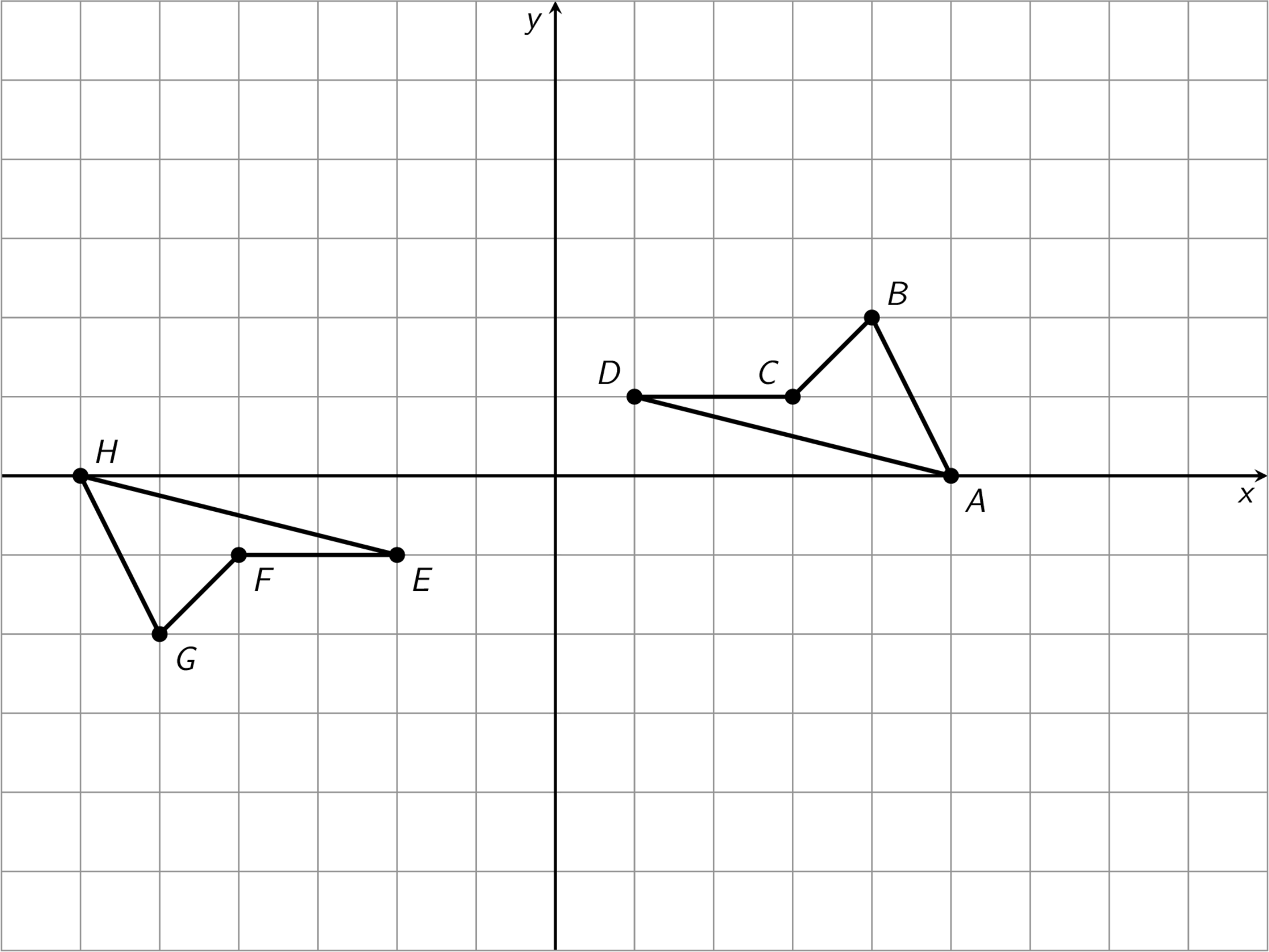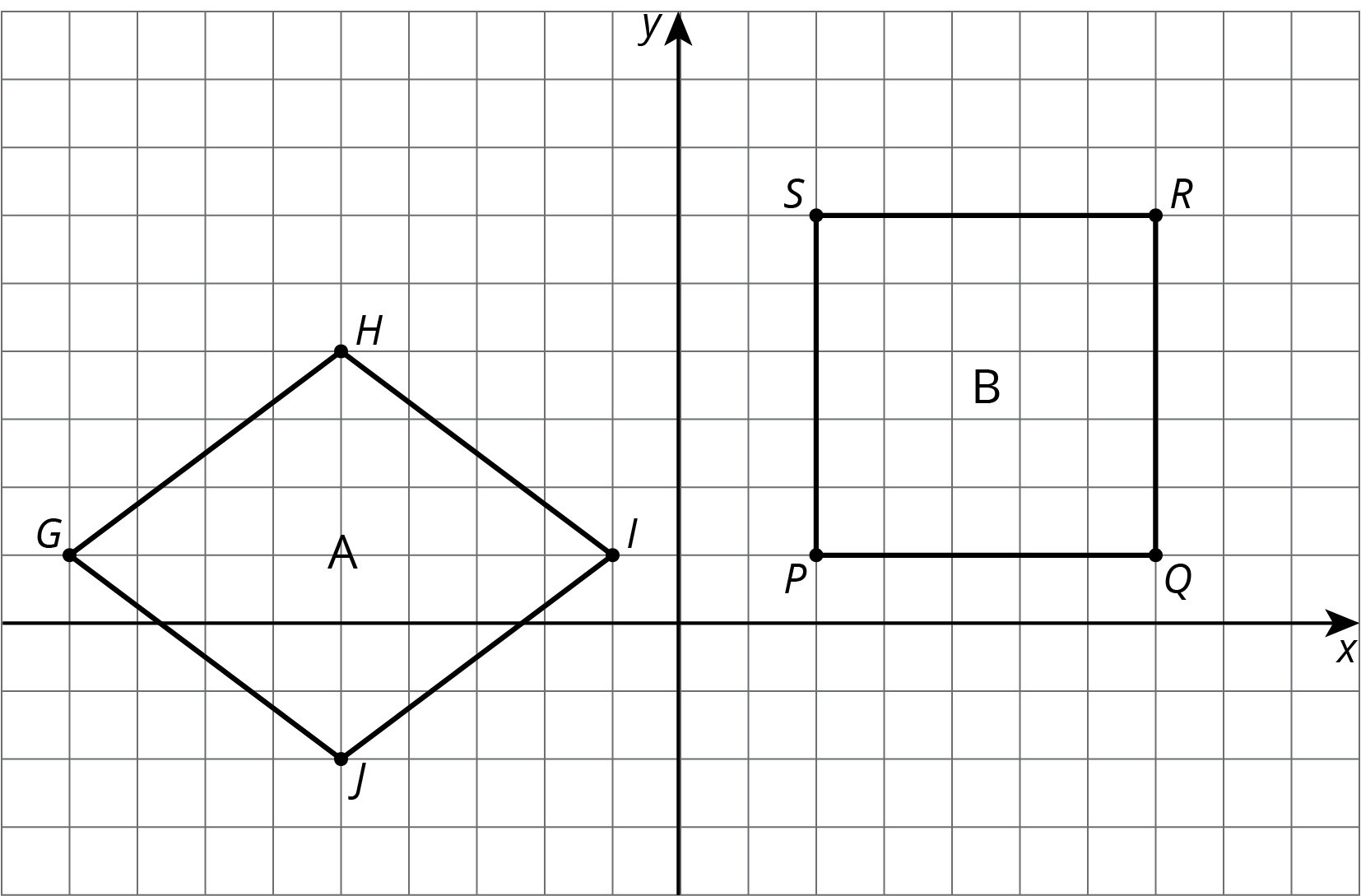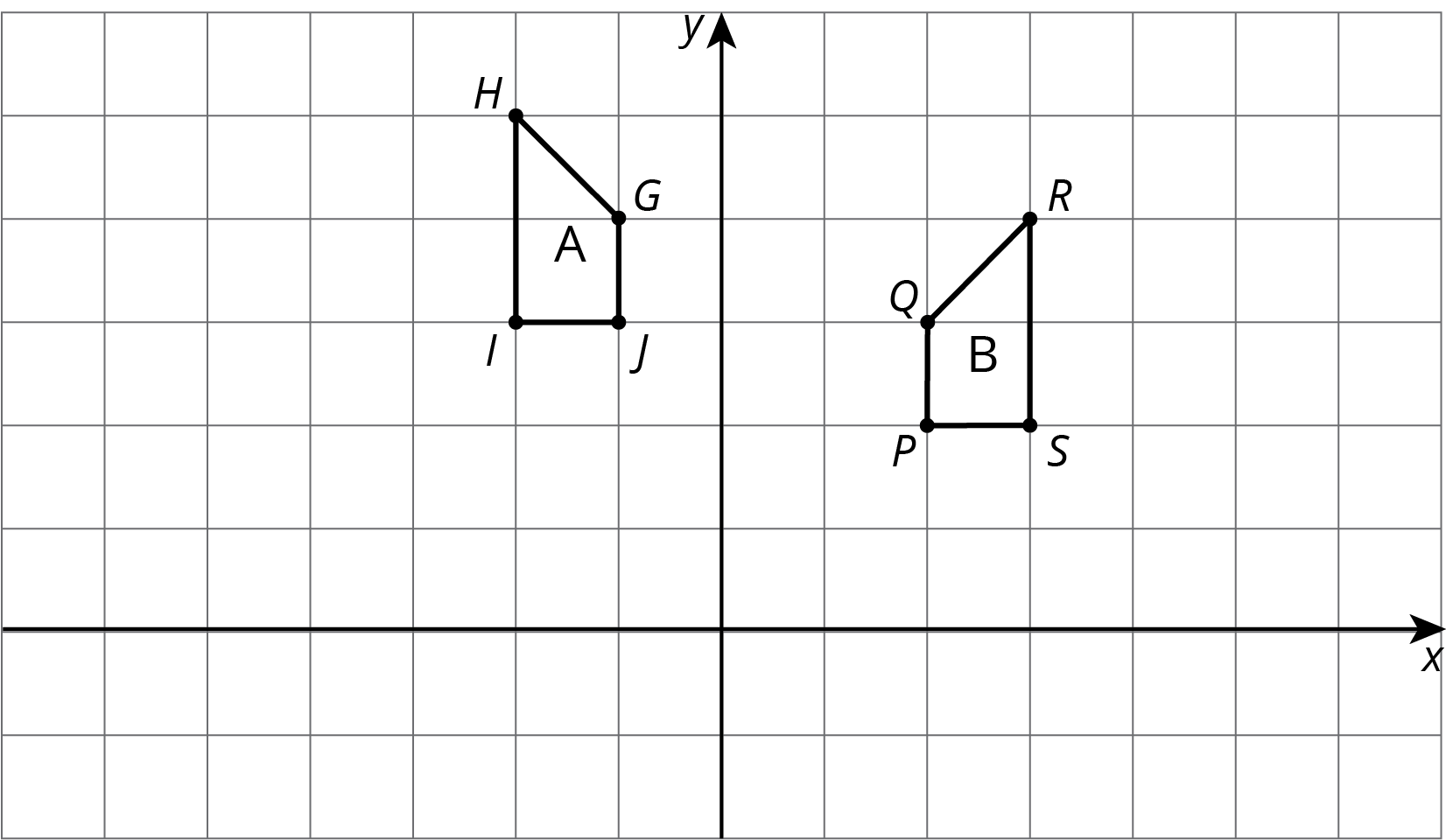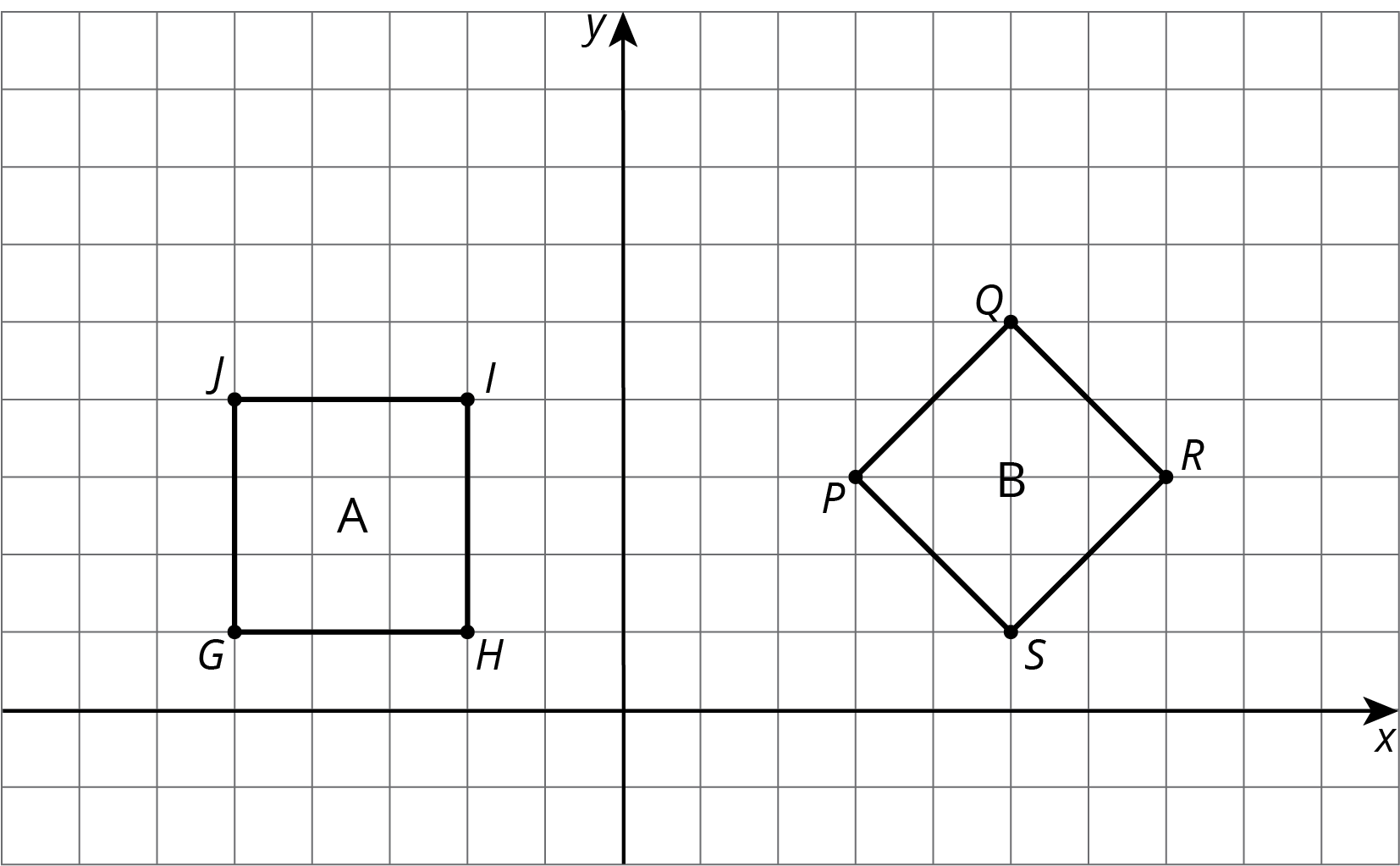Lesson 11
Congruence
11.1: Translated Images (5 minutes)
Warm-up
This task helps students think strategically about what kinds of transformations they might use to show two figures are congruent. Being able to recognize when two figures have either a mirror orientation or rotational orientation is useful for planning out a sequence of transformations.
Launch
Provide access to geometry toolkits. Allow for 2 minutes of quiet work time followed by a whole-class discussion.
Student Facing
All of these triangles are congruent. Sometimes we can take one figure to another with a translation. Shade the triangles that are images of triangle \(ABC\) under a translation.

Student Response
For access, consult one of our IM Certified Partners.
Anticipated Misconceptions
If any students assert that a triangle is a translation when it isn’t really, ask them to use tracing paper to demonstrate how to translate the original triangle to land on it. Inevitably, they need to rotate or flip the paper. Remind them that a translation consists only of sliding the tracing paper around without turning it or flipping it.
Activity Synthesis
Point out to students that if we just translate a figure, the image will end up pointed in the same direction. (More formally, the figure and its image have the same mirror and rotational orientation.) Rotations and reflections usually (but not always) change the orientation of a figure.
For a couple of the triangles that are not translations of the given figure, ask what sequence of transformations would show that they are congruent, and demonstrate any rotations or reflections required.
11.2: Congruent Pairs (15 minutes)
Activity
In the previous lesson, students formulated a precise mathematical definition for congruence and began to apply transformations to determine whether or not pairs of figures are congruent. This activity is a direct continuation of that work with the extra structure of a square grid. The square grid can be a helpful structure for describing the different transformations in a precise way. For example, with translations we can talk about translating up or down or to the left or right by a specified number of units. Similarly, we can readily reflect over horizontal and vertical lines and perform some simple rotations. Students may also wish to use tracing paper to help execute these transformations (MP5).
Students are given several pairs of shapes on grids and asked to determine if the shapes are congruent. The congruent shapes are deliberately chosen so that more than one translation, rotation, or reflection is required to show the congruence. In these cases, students will likely find different ways to show the congruence. Monitor for different sequences of transformations that show congruence. For example, for the first pair of quadrilaterals, some different ways are:
- translate \(EFGH\) 1 unit to the right, and then rotate its image \(180^\circ\) about \((0,0)\)
- reflect \(ABCD\) over the \(x\)-axis, then reflect its image over the \(y\)-axis, and then translate this image 1 unit to the left
For the pairs of shapes that are not congruent, students need to identify a feature of one shape not shared by the other in order to argue that it is not possible to move one shape on top of another with rigid motions. At this early stage, arguments can be informal. Monitor for students who identify that:
- the side lengths are different so it is not possible to make them match up
- the angles are different so the two shapes can not be made to match up
- the areas of the shapes are different
Launch
Provide access to geometry toolkits. Allow for 5–10 minutes of quiet work time followed by a whole-class discussion.
Supports accessibility for: Organization; Attention
Student Facing
For each of the following pairs of shapes, decide whether or not they are congruent. Explain your reasoning.
Student Response
For access, consult one of our IM Certified Partners.
Student Facing
Are you ready for more?
A polygon has 8 sides: five of length 1, two of length 2, and one of length 3. All sides lie on grid lines. (It may be helpful to use graph paper when working on this problem.)
-
Find a polygon with these properties.
-
Is there a second polygon, not congruent to your first, with these properties?
Student Response
For access, consult one of our IM Certified Partners.
Anticipated Misconceptions
Students may want to visually determine congruence each time or explain congruence by saying, “They look the same.” Encourage those students to explain congruence in terms of translations, rotations, reflections, and side lengths. For students who focus on features of the shapes such as side lengths and angles, ask them how they could show the side lengths or angle measures are the same or different using the grid or tracing paper.
When discussing congruence for the second to last question, students may say that quadrilateral \(GHIJ\) is congruent to quadrilateral \(PQRS\) due to wanting to use an alphabetical ordering of the letters, but this is not correct. After a set of transformations is applied to quadrilateral \(GHIJ\), it corresponds to quadrilateral \(QRSP\). The vertices must be listed in this order to accurately communicate the correspondence between the two congruent quadrilaterals.
For the last question, students may be correct in saying the shapes are not congruent but for the wrong reason. They may say one is a 3-by-3 square and the other is a 2-by-2 square, counting the diagonal side lengths as one unit. If so, have them compare lengths by marking them on the edge of a card, or measuring them with a ruler.
Activity Synthesis
Survey the class, perhaps using a show of hands, to identify which shapes are congruent (1 and 4) and which ones are not (2, 3, and 5). For the congruent shapes, ask which motions (translations, rotations, or reflections) students used, and select previously identified students to show different methods. Sequence the methods from most steps to fewest steps when possible.
For the shapes that are not congruent, invite students to identify features that they used to show this and ask students if they tried to move one shape on top of the other. If so, what happened? It is important for students to notice typical reasoning when identifying congruent or non-congruent figures.
The purpose of the discussion is to understand that when two shapes are congruent, there is a rigid transformation that matches one shape up perfectly with the other. Choosing the right sequence takes practice. Students should be encouraged to experiment, using technology and tracing paper when available. When two shapes are not congruent, there is no rigid transformation that matches one shape up perfectly with the other. It is not possible to perform every possible sequence of transformations in practice, so to show that one shape is not congruent to another, we identify a property maintained by rigid transformations of one shape that is not shared by the other. For the shapes in this problem set, students can focus on side lengths or angles. Since transformations do not change side lengths or angles, this is enough to conclude that the two shapes are not congruent.
Design Principle(s): Maximize meta-awareness; Support sense-making
11.3: Corresponding Points in Congruent Figures (15 minutes)
Activity
Corresponding sides of congruent polygons have the same length. For shapes like ovals, examined in the previous activity, there are no “sides.” However, if points \(A\) and \(B\) on one figure correspond to points \(A’\) and \(B’\) on a congruent figure, then the length of segment \(AB\) is equal to the length of segment \(A’B’\) because translations, rotations, and reflections do not change distances between points. Students have seen and worked with this idea in the context of polygons and their sides. This remains true for other shapes as well.
Because rigid motions do not change distances between points, corresponding points on congruent figures (even oddly shaped figures!) are the same distance apart. This is one more good example MP7 as the fundamental mathematical property of rigid motions is that they do not change distances between corresponding points: this idea holds for any points on any congruent figures.
There are two likely strategies for identifying corresponding points on the two corresponding figures:
- Looking for corresponding parts of the figures such as the line segments
- Performing rigid motions with tracing paper to match the figures up
Both are important. Watch for students using each technique and invite them to share during the discussion.
This activity originally followed one that examined four ovals on a grid and asked students to decide if any of the ovals were congruent. Since the oval activity is not used in IM 6–8 Math Accelerated, Replace the Launch with this shortened version of it to help prepare students for the main activity:
Display the image for all to see:
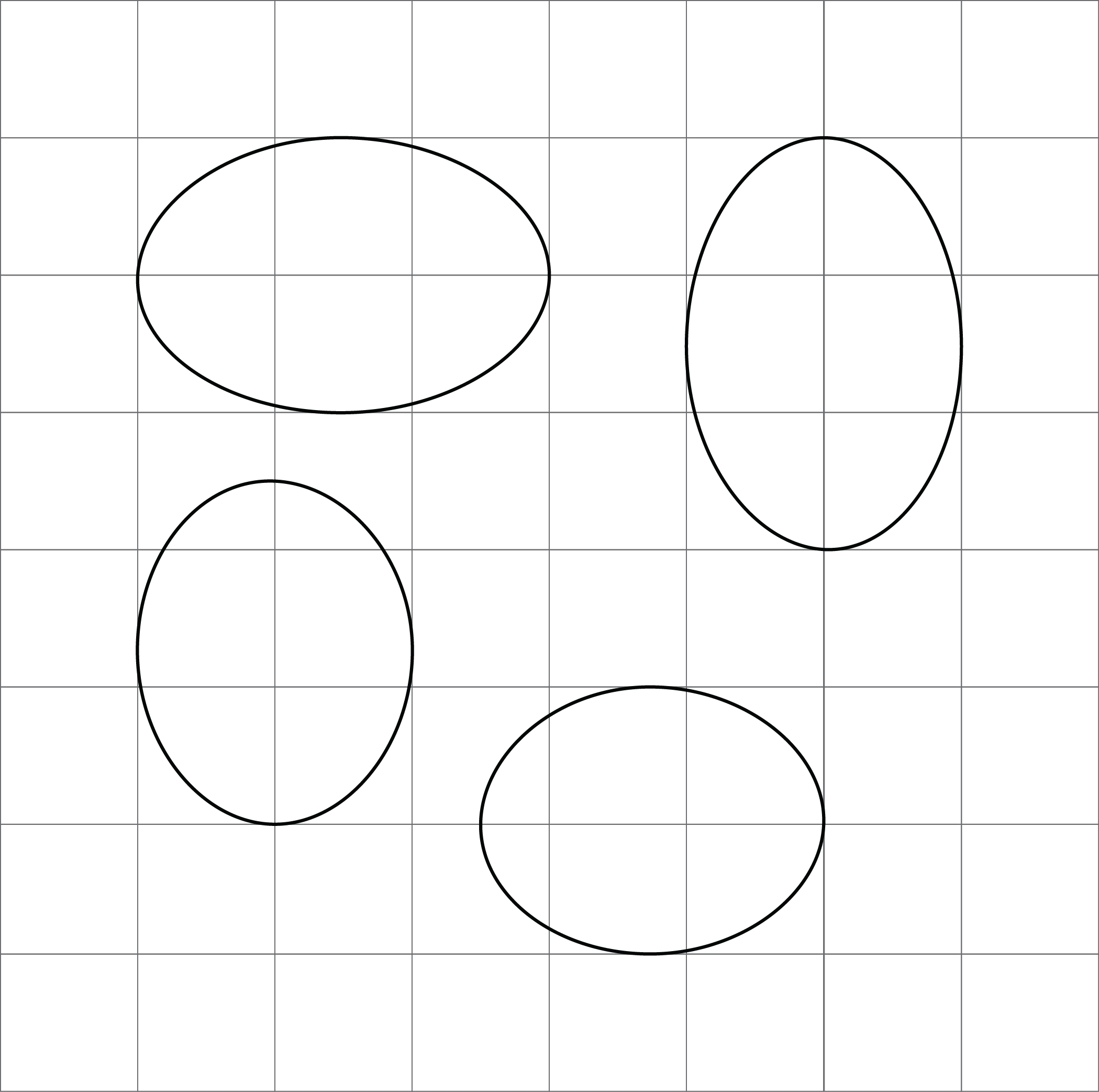
Arrange students in groups of 2. Provide access to geometry toolkits. Allow for 5 minutes of quiet work time followed by sharing with a partner and a whole-class discussion.
Supports accessibility for: Social-emotional skills; Conceptual processing
Launch
Keep students in the same groups. Allow for 5 minutes of quiet work time followed by sharing with a partner and a whole-class discussion. Provide access to geometry toolkits (rulers are needed for this activity).
Supports accessibility for: Language; Organization
Student Facing
Here are two congruent shapes with some corresponding points labeled.

-
Draw the points corresponding to \(B\), \(D\), and \(E\), and label them \(B’\), \(D’\), and \(E’\).
-
Draw line segments \(AD\) and \(A’D’\) and measure them. Do the same for segments \(BC\) and \(B’C’\) and for segments \(AE\) and \(A’E’\). What do you notice?
-
Do you think there could be a pair of corresponding segments with different lengths? Explain.
Student Response
For access, consult one of our IM Certified Partners.
Activity Synthesis
Ask selected students to show how they determined the points corresponding to \(B\), \(D\), and \(E\), highlighting different strategies (identifying key features of the shapes and performing rigid motions). Ask students if these strategies would work for finding \(C'\) if it had not been marked. Performing rigid motions matches the shapes up perfectly, and so this method allows us to find the corresponding point for any point on the figure. Identifying key features only works for points such as \(A\), \(B\), \(D\), and \(E\), which are essentially like vertices and can be identified by which parts of the figures are “joined” at that point.
While it is challenging to test “by eye” whether or not complex shapes like these are congruent, the mathematical meaning of the word “congruent” is the same as with polygons: two shapes are congruent when there is a sequence of translations, reflections, and rotations that match up one shape exactly with the other. Because translations, reflections, and rotations do not change distances between points, any pair of corresponding segments in congruent figures will have the same length.
If time allows, have students use tracing paper to make a new figure that is either congruent to the shape in the activity or slightly different. Display several for all to see and poll the class to see if students think the figure is congruent or not. Check to see how the class did by lining up the new figure with one of the originals. Work with these complex shapes is important because we tend to rely heavily on visual intuition to check whether or not two polygons are congruent. This intuition is usually reliable unless the polygons are complex or have very subtle differences that cannot be easily seen. The meaning of congruence in terms of rigid motions and our visual intuition of congruence can effectively reinforce one another:
- If shapes look congruent, then we can use this intuition to find the right motions of the plane to demonstrate that they are congruent.
- Through experimenting with rigid motions, we increase our visual intuition about which shapes are congruent.
Design Principle(s): Maximize meta-awareness; Support sense-making
Lesson Synthesis
Lesson Synthesis
This lesson wraps up work on congruence. Important points to highlight include:
- Two figures are congruent when there is a sequence of translations, rotations, and reflections that match one figure up perfectly with the other. (This is from the previous lesson but it is vital to thinking in this lesson as well.)
- When showing that two figures are congruent on a grid, we use the structure of the grid to describe each rigid motion. For example, translations can be described by indicating how many grid units to move left or right and how many grid units to move up or down. Reflections can be described by indicating the line of reflection. (An axis or a particular grid line are readily available.)
- To show that two figures are not congruent it is enough to find corresponding points on the figures which are not the same distance apart, or corresponding angles that have different measure.
- The distance between pairs of corresponding points in congruent figures is the same. (This says that corresponding side lengths on polygons have the same length but it applies to curved figures also or to any pair of points, not necessarily vertices, on polygons.)
11.4: Cool-down - Explaining Congruence (5 minutes)
Cool-Down
For access, consult one of our IM Certified Partners.
Student Lesson Summary
Student Facing
How do we know if two figures are congruent?
- If we copy 1 figure on tracing paper and move the paper so the copy covers the other figure exactly, then that suggests they are congruent.
- We can prove that 2 figures are congruent by describing a sequence of translations, rotations, and reflections that move 1 figure onto the other so they match up exactly.
- Distances between corresponding points on congruent figures are always equal, even for curved shapes. For example, corresponding segments \(AB\) and \(A’B’\) on these congruent ovals have the same length:
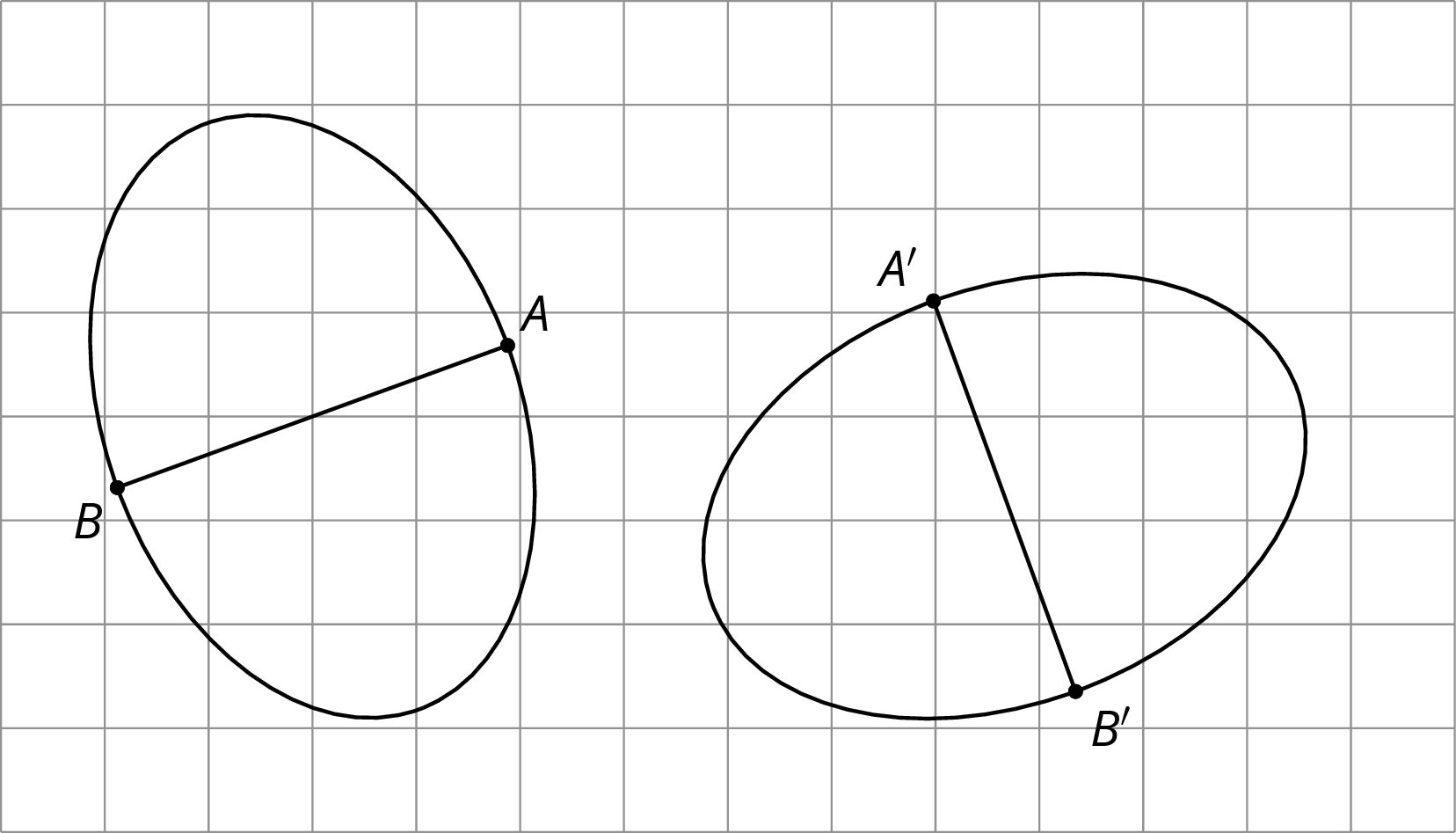
How do we know that 2 figures are not congruent?
- If there is no correspondence between the figures where the parts have equal measure, that proves that the two figures are not congruent. In particular,
-
If two polygons have different sets of side lengths, they can’t be congruent. For example, the figure on the left has side lengths 3, 2, 1, 1, 2, 1. The figure on the right has side lengths 3, 3, 1, 2, 2, 1. There is no way to make a correspondence between them where all corresponding sides have the same length.
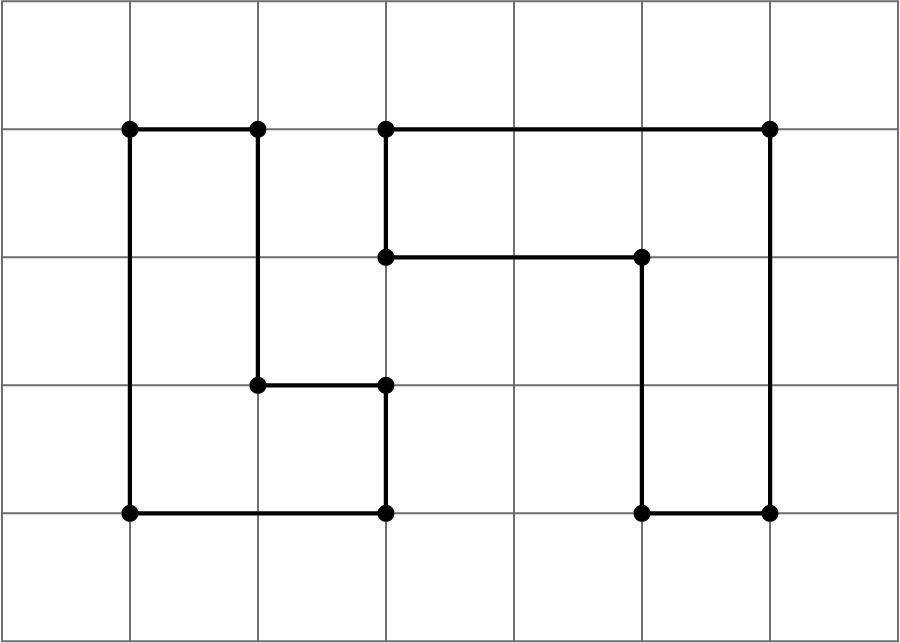
- If two polygons have the same side lengths, but their orders can’t be matched as you go around each polygon, the polygons can’t be congruent. For example, rectangle \(ABCD\) can’t be congruent to quadrilateral \(EFGH\). Even though they both have two sides of length 3 and two sides of length 5, they don’t correspond in the same order. In \(ABCD\), the order is 3, 5, 3, 5 or 5, 3, 5, 3; in \(EFGH\), the order is 3, 3, 5, 5 or 3, 5, 5, 3 or 5, 5, 3, 3.
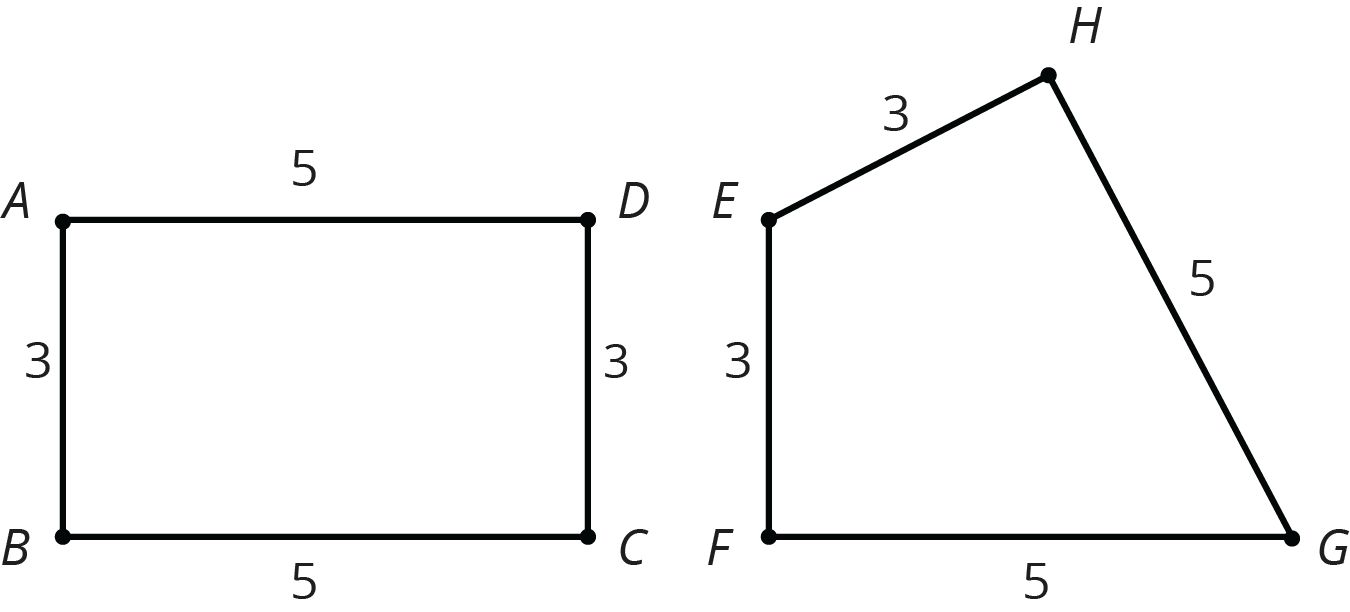
-
If two polygons have the same side lengths, in the same order, but different corresponding angles, the polygons can’t be congruent. For example, parallelogram \(JKLM\) can’t be congruent to rectangle \(ABCD\). Even though they have the same side lengths in the same order, the angles are different. All angles in \(ABCD\) are right angles. In \(JKLM\), angles \(J\) and \(L\) are less than 90 degrees and angles \(K\) and \(M\) are more than 90 degrees.
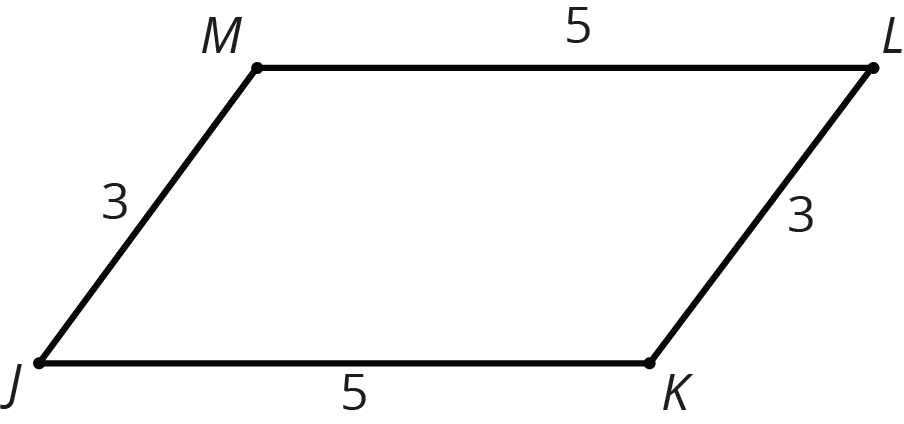
- If you have curved figures, like these 2 ovals, you can find parts of the figures that should correspond but that have different measurements. On both, the longest distance from left to right is 5 units across, and the longest distance from top to bottom is 4 units. The line segment from the highest to lowest point is in the middle of the left oval, but in the right oval, it’s 2 units from the right end and 3 units from the left end. This proves they are not congruent.
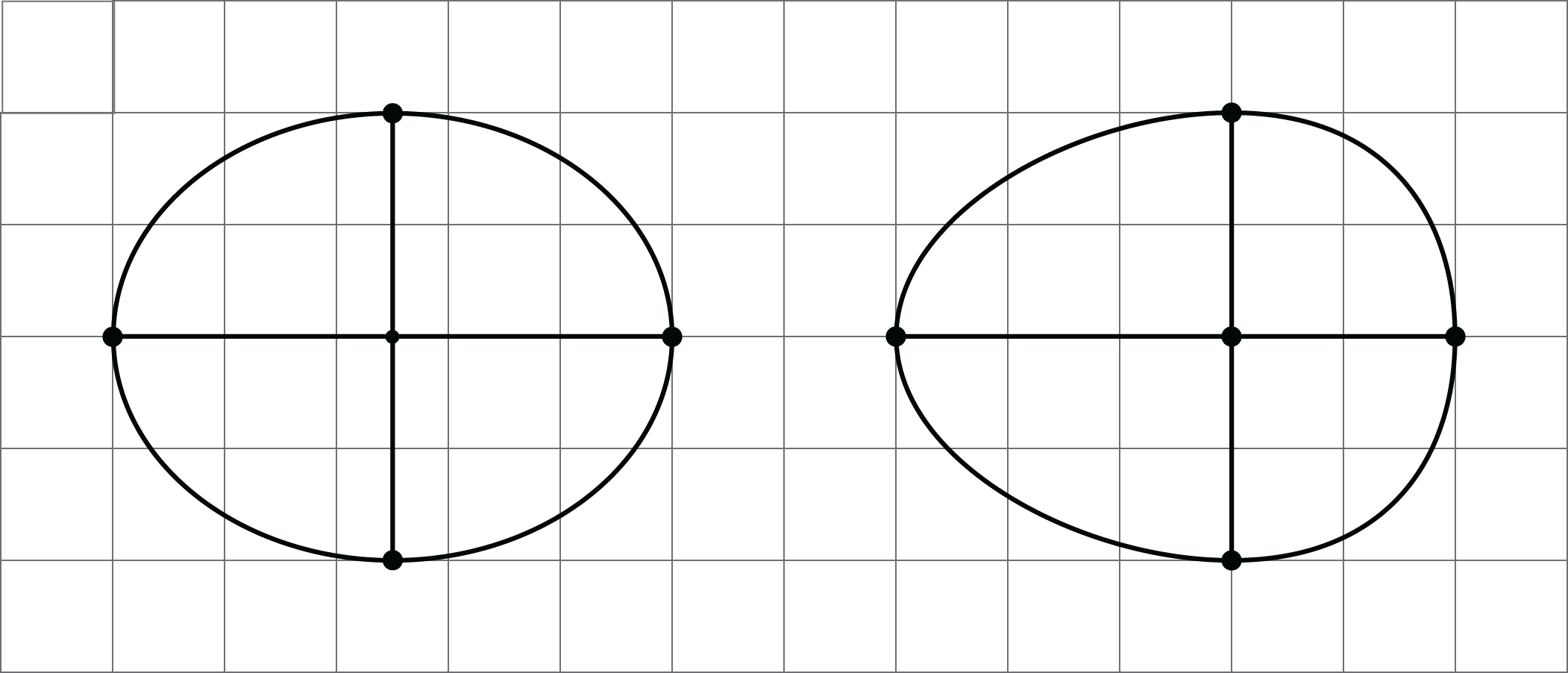
-
